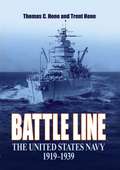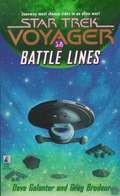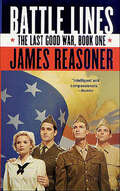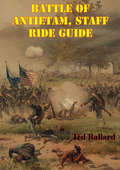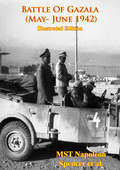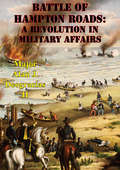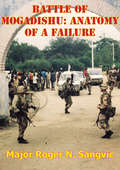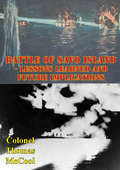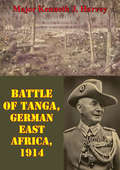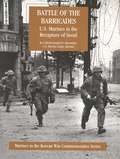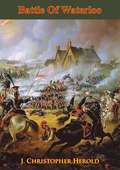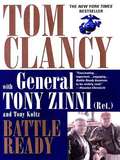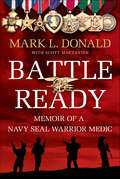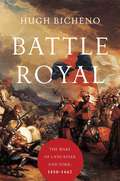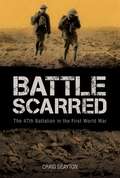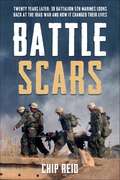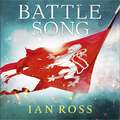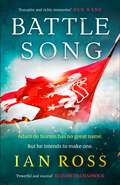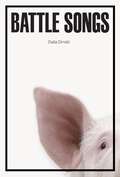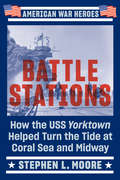- Table View
- List View
Battle Leadership: Some Personal Experiences of a Junior Officer of the German Army with Observations on Battle Tactics and the Psychological Reactions of Troops in Campaign
by Adolf Von SchellA collection of lessons learned by Adolf von Schell, a small unit infantry commander during World War I.
Battle Line
by Thomas C. Hone Trent HoneA portrait in words and photographs of the interwar Navy, this book examines the twenty-year period that saw the U.S. fleet shrink under the pressure of arms limitation treaties and government economy and then grow again to a world-class force. The authors trace the Navy's evolution from a fleet centered around slow battleships to one that deployed most of the warship types that proved so essential in World War II, including fast aircraft carriers, heavy and light cruisers, sleek destroyers, powerful battleships, and deadly submarines. Both the older battleships and these newer ships are captured in stunning period photographs that have never before been published. An authoritative yet lively text explains how and why the newer ships and aircraft came to be. Thomas Hone and Trent Hone describe how a Navy desperately short funds and men nevertheless pioneered carrier aviation, shipboard electronics, code-breaking, and (with the Marines) amphibious warfare - elements that made America's later victory in the Pacific possible. Based on years of study of official Navy department records, their book presents a comprehensive view of the foundations of a navy that would become the world's largest and most formidable. At the same time, the heart of the book draws on memoirs, novels, and oral histories to reveal the work and the skills of sailors and officers that contributed to successes in World War II. From their service on such battleships as West Virginia to their efforts ashore to develop and procure the most effective aircraft, electronics, and ships, from their adventures on Yangtze River gunboats to carrier landings on the converted battle cruisers Saratoga and Lexington, the men are profiled along with their ships. This combination of popular history with archival history will appeal to a general audience of naval enthusiasts.
Battle Lines: Star Trek Voyager (Star Trek: Voyager #18)
by Dave Galanter Greg BrodeurWhile exploring a sector of uncharted space, the U.S.S. Voyager is ambushed -- and forcibly pressed into service as part of the Edesian Fleet in their war against the enemy Gimlon. The Edesian commander claims that the Fleet is fighting only to defend his people against a merciless invader, but Captain Janeway is suspicious. War, she has learned, is seldom so simple or black and white. With Chakotay and several other crew members held hostage, and the Starship Voyager under the control of the Edesians, Janeway has no choice but to join the campaign against the Gimlon, only to discover that the enemy has developed a new super-weapon capable of destroying entire worlds. Soon the Captain and her crew find themselves fighting a losing battle in a war they never wanted!
Battle Lines: The Last Good War, Book One (The Last Good War #1)
by James ReasonerIt is 1941, and friends Adam, Joe, Dale, and Catherine are similar to most young adults. College, dating, and fast cars are what they know and live for. And in Chicago, Illinois, the near center of America, world conflict seems merely a distant rumor.But as turmoil in Europe develops into full-scale war, Chicago suddenly abounds with talk of America's entering the fight. Drawn by the promise of freedom and the allure of battle, Joe and Dale join the Army, Adam the Marines, and Catherine the Naval Nurse Service. Far away from home and facing the reality of war in all its horror, they find the world a frighteningly big and unforgiving place, and what began as a quest for freedom becomes a battle to stay alive in one of the bloodiest wars of the twentieth century.At the Publisher's request, this title is being sold without Digital Rights Management Software (DRM) applied.
Battle Of Antietam, Staff Ride Guide [Illustrated Edition]
by Ted BallardContains more than 20 maps, diagrams and illustrationsThe Battle of Antietam has been called the bloodiest single day in American History. By the end of the evening, 17 September 1862, an estimated 4,000 American soldiers had been killed and over 18,000 wounded in and around the small farming community of Sharpsburg, Maryland. Emory Upton, then a captain with the Union artillery battery, later wrote, "I have heard of 'the dead lying in heaps,' but never saw it till this battle. Whole ranks fell together." The battle had been a day of confusion, tactical blunders, individual heroics, and the effects of just plain luck. It brought to an end a Confederate campaign to "liberate" the border state of Maryland and possibly take the war into Pennsylvania. A little more than one hundred and forty years later, the Antietam battlefield is one of the best-preserved Civil War battlefields in the National Park System.Antietam is ideal for a staff ride, since a continuing goal of the National Park Service is to maintain the site in the condition in which it was on the day of the battle. The purpose of any staff ride is to learn from the past by analyzing the battle through the eyes of the men who were there, both leaders and rank-and-file soldiers. Antietam offers many lessons in command and control, communications, intelligence, weapons technology versus tactics, and the ever-present confusion, or "fog" of battle. We hope that these lessons will allow us to gain insights into decision-making and the human condition during combat.
Battle Of Aschaffenburg: An Example Of Late World War II Urban Combat In Europe
by Major Quentin W. SchillareThe Battle of Aschaffenburg examines the fight for the Main River city of Aschaffenburg in the closing weeks of World War II in Europe. It investigates the reasons why it took mobile and well supported elements of the U.S. Army ten days to subdue a defending German military force that was very much militia in character. After setting the battle in the context of Nazi Germany and the Aschaffenburg region just prior to the fight, the study takes the reader through the battle day-by-day describing the struggle and establishing the reasons why it was so prolonged.The study groups the reasons for the successful German defense into three categories: terrain, operational factors and behavioral determinants. It establishes that the terrain favored the defenders with the town located across the Main River from the attackers so that they were forced into frontal assaults. Granting favorable defensive terrain, it was not until a numerically superior attacking force enveloped the urban defenses, under the cover of massive fire support, that the Americans gained the upper hand. The study further demonstrates the Impact of the concept of the will to win on military operations, even in a hopeless cause.The Battle of Aschaffenburg addresses Europe an urban combat in the context of World War II and concludes that the factors relevant to success then are still applicable. An attacker must carefully plan operations in urbanized terrain, follow doctrine and be physically and mentally prepared for a difficult fight.
Battle Of Ball’s Bluff, Staff Ride Guide [Illustrated Edition]
by Ted BallardContains more than 20 maps, diagrams and illustrationsOn the night of 20 October 1861, Union Brig. Gen. Charles P. Stone put into action a plan to attack what had been reported as a small, unguarded Confederate camp between the Potomac River at Ball's Bluff and Leesburg, Virginia. Later, after Stone learned there was no camp, he allowed the operation to continue, now modified to capture Leesburg itself. But a lack of adequate communication between commanders, problems with logistics, and violations of the principles of war hampered the operation. What originally was to be a small raid instead turned into a military disaster. The action resulted in the death of a popular U.S. senator and long-time friend of President Abraham Lincoln, the arrest and imprisonment of General Stone, and the creation of a congressional oversight committee that would keep senior Union commanders looking over their shoulders for the remainder of the war. For such a small and relatively insignificant military action, Ball's Bluff would cast a long shadow. The purpose of a Ball's Bluff staff ride is to learn from the past by analyzing the battle through the eyes of the men who were there, both leaders and rank-and-file soldiers. The battle contains many lessons in command and control, communications, intelligence, weapons technology versus tactics, and the ever-present confusion, or "fog," of battle. Hopefully, these lessons will allow us to gain insights into decision making and the human condition during combat. Today, the battlefield is enclosed in the 225-acre Ball's Bluff Regional Park, managed by the Northern Virginia Regional Park Authority. A short trail includes interpretive markers and a small national cemetery containing the remains of fifty-four soldiers.
Battle Of Crete: Hitler’s Airborne Gamble
by Major Maria A. BiankAs Adolf Hitler conquered most of the European continent in 1939-1941, the small island of Crete in the Mediterranean Sea became vital to future operations in the Mediterranean region for both the Axis and Allied powers. If the Allies controlled Crete, their air and sea superiority would not allow the Germans a strategic military foothold in the region. For the Germans, Crete would secure the Aegean Sea for Axis shipping, loosen Great Britain's grasp in the eastern Mediterranean Sea and provide air bases to launch offensives against British forces in Egypt. Therefore, the central research question is: Did the results of the German campaign in Crete justify its execution? The operational results of the German campaign in Crete and the strategic advantages gained from its success did not justify the execution of the battle. Although Germany's conquest of Crete achieved all of the strategic advantages, Hitler did not accomplish the strategic objectives set forth at the beginning of the campaign. Crete was not used as a staging base from which to engage the British in offensive operations against the Suez Canal or North Africa. German losses to the highly trained air corps were staggering and Hitler never again employed parachutists on a large-scale airborne operation. Future war efforts were deprived of this elite, highly mobile striking force. Hitler did not capitalize on the hard fought victory in Crete by using the island as a stepping-stone, ultimately controlling the eastern Mediterranean region because he was hypnotized by the invasion of Russia.
Battle Of Gazala (May- June 1942) [Illustrated Edition]
by Msg Napoleon SpencerIncludes the War in North Africa Illustration Pack - 112 photos/illustrations and 21 maps.The Battle of Gazala, fought from 26 May-20 June 1942, was Rommel's greatest triumph in battle. It is also considered the most convincing defeat of British forces during all the desert campaigns of World War II. Rommel's success was a demanding effort and rested on the exploitation of British weaknesses. It required an understanding of the environment, a commitment to the essential principles of war, and the ability and willingness to maintain initiative. The Battle of Gazala was not just a mastery of warfare by Rommel; it also illustrated (for both sides) the importance of logistics, maneuver, mass, and surprise (FM 3-0, 4-13).When analyzed individually, one, if not all the factors discussed possesses the potential to be the most significant factor(s) in the British defeat at Gazala. The Germans, specifically Rommel, understood how to combine leadership, logistics, mass, and maneuver to impose their will on the British. The British failed to incorporate lessons learned into their plans rendering them incapable of dealing with a mobile war in the Northern Desert. The Battle of Gazala in itself may not profess to be Rommel's great triumph in battle. However, Rommel's ability to apply the principles of war while outnumbered and trapped, and turning defeat into victory could very well define the Battle of Gazala as his finest moment in battle.Analysis of the Battle of Gazala provides several lessons concerning the outcome and whether or not it could be considered Rommel's greatest triumph in battle. Examining the factors presented thus far it could be concluded that British should have had the upper hand.
Battle Of Hampton Roads: A Revolution In Military Affairs
by Major Alan J. Deogracias IIThis thesis examines the Battle of Hampton Roads, 8 and 9 March 1862, the first battle of ironclads, to determine if it was a Revolution in Military Affairs. This study is an analysis of naval developments prior to March 1862, the battle, and the impact the battle had on the U.S. Navy and the Royal Navy from 1862 to 1871. The battle signaled the end of the wooden warship era when the CSS Virginia destroyed two wooden warships on 8 March 1862. The USS Monitor influenced a change in naval design, which led the U.S. Navy and the Royal Navy to build turreted warships, which culminated in the launching of the first modern battleship in 1871. The transformation from sailing and steam ships with broadside armament to steam-powered turret ships led to a reduction in the size of the crews and the acceptance of engineers into the naval community. The battle led both navies to assign ironclads to their squadrons to counter ironclads of hostile nations. The battle influenced the development of tactics for fighting ironclads including ramming and coastal warfare. The Battle of Hampton Roads was a Revolution in Military Affairs and the onset of modern naval warfare.
Battle Of Mogadishu: Anatomy Of A Failure
by Major Roger N. SangvicBy applying Cohen and Gooch's model to the Battle of Mogadishu, this paper shows that the failure of the TFR mission on 3-4 October 1993 was the result of a system failure. Secretary Aspin received far more blame than he deserved for making the decision. Misperception of the real impact tanks and APCs could have had on the overall mission is the real cause of this disproportionate blame. GEN Hoar and GEN Powell, in addition, bear as much responsibility as Secretary Aspin for the decision. Neither of these generals strongly advocated the deployment to Aspin even though the worsening situation on the ground merited their strong support. Both Hoar and Powell's approval recommendations can be characterized as lukewarm. Aspin's real failure was of not being more critical of the conduct of the TFR operations. In light of Secretary Aspin's acknowledged concern over the number of similar operations conducted by TFR and his knowledge that the Administration was seeking a political solution, he should have notified MG Garrison of the policy shift though the JCS and CINCCENT and provided additional guidance on risk. Had Aspin either reassessed the risk of each TFR operation more thoroughly or done a better job coordinating the policy shift in light of the increased risks, it is likely that the three October raid would not have occurred.
Battle Of Savo Island - Lessons Learned And Future Implications
by Colonel Thomas MccoolAs the United States enters into the 21st century, it will face new and different challenges that will be more complex than those encountered in the past. Evolutions in doctrine, training, and equipment modernization, influenced by informational and technological advances, will enhance U.S. ability to accomplish national objectives. Valuable lessons learned can be realized by studying past operations that failed to understand the threat and capitalize on friendly capabilities. The Battle of Savo Island in August 1942 is one such event. This short but violent naval engagement, a daring Japanese night surface attack conducted at the beginning of the Guadalcanal campaign on 9 August 1942, was a significant tactical victory for the Imperial Japanese Fleet and has been called the worst blue water defeat in the U.S. Navy's history. This paper will address the shortcomings at Savo Island, particularly in terms of intelligence, command and control, training, force protection, and leadership and discuss these concepts as they apply to current and future operations in the 21st century.
Battle Of Tanga, German East Africa, 1914
by Major Kenneth J. HarveyIn November 1914, British Indian Expeditionary Force "B" conducted an amphibious assault on the Port of Tanga in German East Africa. The British possessed all the tools required for success; they outnumbered the defenders almost eight to one, they possessed the only artillery and naval guns available for the battle, and they landed where the Germans were weak. Despite these factors, a hastily organized German defense force of 1,100 soldiers not only defeated the 8,000 British soldiers, but also compelled Indian Expeditionary Force "B" to retreat to Mombasa.This thesis examines the manner in which German and British forces were organized, trained, equipped, and led. Additionally, it identifies the critical factors that together led to British defeat at Tanga.
Battle Of The Barricades: U.S. Marines In The Recapture Of Seoul [Illustrated Edition] (Marines In The Korean War Commemorative Series #2)
by Colonel Joseph H. Alexander USMCIncludes over 30 maps, photos and illustrationsThe Second Battle of Seoul was the battle to recapture Seoul from the North Koreans in late September 1950.The advance on Seoul was slow and bloody, after the landings at Inchon. The reason was the appearance in the Seoul area of two first-class fighting units of the North Korean People's Army, the 78th Independent Infantry Regiment and 25th Infantry Brigade, about 7,000 troops in all.The NKPA launched a T-34 attack, which was trapped and destroyed, and a Yak bombing run in Incheon harbor, which did little damage. The NKPA attempted to stall the UN offensive to allow time to reinforce Seoul and withdraw troops from the south. Though warned that the process of taking Seoul would allow remaining NKPA forces in the south to escape, MacArthur felt that he was bound to honor promises given to the South Korean government to retake the capital as soon as possible.On September 22, the Marines entered Seoul to find it heavily fortified. Casualties mounted as the forces engaged in desperate house-to-house fighting. Anxious to pronounce the conquest of Seoul, Almond declared the city liberated on September 25 despite the fact that Marines were still engaged in house-to-house combat. Despite furious resistance by the North Korean forces, the Marines triumphed; pushing the communists soldiers out of Seoul. This U.S. Marine Corps history provides unique information about this important battle of the Korean War.
Battle Of Waterloo [Illustrated Edition]
by J. Christopher Herold Jean HanoteauIllustrated with documents, paintings, and relics of the period. Renowned Napoleonic historian, J. Christopher Herold recounts the fascinating details of the great battle of Waterloo which ended the career of the greatest conqueror of modern times--Napoleon Bonaparte, Emperor of the French.
Battle Ready
by Tom Clancy Tony Koltz Tony ZinniMarine general Tony Zinni was known as the "Warrior Diplomat" during his nearly forty years of service. His credentials as a soldier were impeccable, whether he was leading troops in Vietnam, commanding hair-raising rescue operations in Somalia, or - as Commander in Chief of CENTCOM - directing strikes against Iraq and Al Qaeda. But it was as a peacemaker that he made just as great a mark - conducting dangerous troubleshooting missions all over Africa, Asia, and Europe, and then serving as Secretary of State Colin Powell's special envoy to the Middle East, before disagreements over the 2003 Iraq war and its probable aftermath caused him to resign." Battle Ready follows the evolution of both General Zinni and the Marine Corps, from the cauldron of Vietnam through the operational revolution of the '70s and '80s, to the new realities of the post-Cold War, post-9/11 military - a military with a radically different tools for accomplishing it. Opinions differ sharply about just what that job and those tools should be - and General Zinni makes it clear where he stands.
Battle Ready: Memoir of a Navy SEAL Warrior Medic
by Scott Mactavish Mark L. Donald“Mark is a true American hero. [His memoir] is a well-written journey from training to combat to recovery.” —Howard Wasdin, New York Times–bestselling author of Seal Team SixAs A SEAL and combat medic, Mark Donald served his country with valorous distinction for almost twenty-five years and survived some of the most dangerous combat actions imaginable.From the rigors of BUD/S training to the horrors of the battlefield, Battle Ready dramatically immerses the reader in the unique life of the elite warrior-medic who advances into combat with life-saving equipment in one hand and life-taking weapons in the other. It is also an uplifting human story that reveals how a young Hispanic American bootstrapped himself out of a life that promised a dead-end future by enlisting in the military. That new life begins with the Marines and includes his heroic achievements on the battlefield and the operating table, and finally, of his inspirational triumph over the demons caused by Post Traumatic Stress Disorder that threatened to destroy him and his family.“A compelling account of a remarkable American’s journey in the military.” —Wade Ishimoto, Former Senior Advisor to Assistant Secretary of Defense, Special Operations/Low Intensity Conflict“Straightforward reflections on what it takes to be the most elite sort of soldier and the hidden costs of that life.” —Kirkus Reviews“A superb description of the infamously brutal weeding-out ordeal of SEAL training, the nuts-and-bolts duties of a medic, and the battle actions that won [Donald] the Navy Cross.” —Publishers Weekly
Battle Royal: 1440-1462 (The\wars Of Lancaster And York Ser. #01)
by Hugh BichenoThe enthralling story of the dynastic wars fought between the houses of Lancaster and York, the first of a dynamic two-volume history of the Wars of the Roses. England, 1454. A kingdom sliding into chaos. The mentally unstable King Henry VI, having struggled for a decade to contain the violent feuding of his dukes, is losing his mind. Disgruntled nobles support the regal claims of Richard, Duke of York, great-grandson of Edward III. The stage is set for civil war. The first volume of an enthralling two-part history of the dynastic wars fought between the houses of Lancaster and York, Battle Royal traces the conflict from its roots in the 1440s to the early 1460s—a period marked by the rise and fall of Richard of York, the deposition of Henry VI following the Lancastrian defeat at Towton, and the subsequent seizure of his throne by Richard's son Edward. Populating this late-medieval saga of ambition, intrigue, and bloodshed are such fascinating characters as the vacillating Henry VI himself, his indefatigable queen Marguerite of Anjou, Richard of York (father of kings but never king himself), his opportunist ally Richard Neville—"the Kingmaker"—and the precociously virile Edward of York. Charting a clear course through the dynastic complexities of fifteenth-century power politics, and offering crisply authoritative analysis of the key battles of the Wars of the Roses, Battle Royal is a dynamic and rigorously researched account of England's longest and bloodiest civil war.
Battle Scarred: The 47th Battalion in the First World War
by Craig Deayton"The dead and wounded of the 47th lay everywhere underfoot". With these words Charles Bean, Australia's Official War Historian, described the battlefield of Dernancourt on the morning of the 5th of April, 1918, strewn with the bodies of the Australian dead. It was the final tragic chapter in the story of the 47th Australian Infantry Battalion in the First World War. One of the shortest lived and most battle hardened of the 1st Australian Imperial Force's battalions, the 47th was formed in Egypt in 1916 and disbanded two years later having suffered one of the highest casualty rates of any Australian unit. Their story is remarkable for many reasons. Dogged by command and discipline troubles and bled white by the desperate attrition battles of 1916 and 1917, they fought on against a determined and skilful enemy in battles where the fortunes of war seemed stacked against them at every turn. Not only did they have the misfortune to be called into some of the A.I.F.'s most costly campaigns, chance often found them in the worst places within those battles. Though their story is one of almost unrelieved tragedy, it is also story of remarkable courage, endurance and heroism. It is the story of the 1st A.I.F. itself - punished, beaten, sometimes reviled for their indiscipline, they fought on - fewer, leaner and harder - until final victory was won. And at its end, in an extraordinary gesture of mateship, the remnants of the 47th Battalion reunited. Having been scattered to other units after their disbandment, the survivors gathered in Belgium for one last photo together. Only 73 remained.
Battle Scars: Twenty Years Later: 3d Battalion 5th Marines Looks Back at the Iraq War and How it Changed Their Lives
by Chip ReidA unique insight into how combat in Iraq has shaped the lives of a battalion of young Marines. The most eye-opening, and terrifying, story in Chip Reid's career as a journalist was the six weeks he spent with 3d Battalion, 5th Marines, during the invasion of Iraq in 2003, as a correspondent for NBC News. Traveling shoulder-to-shoulder with the young Marines, he had unparalleled access, witnessing them in combat, and interviewing as many as he could persuade his bosses to put on air, allowing them to tell their war stories in their own words. It took only 22 days for the Marines of 3/5 to fight their way to Baghdad, but the effects on those who fought have lasted a lifetime. They lost a number of their own in battle, and others suffered life-threatening injuries. Of those who returned - even if they avoided physical scars - many have had to find their own way through survivor's guilt and the nightmare of Post-Traumatic Stress Disorder, with all its attendant miseries. Twenty years on, Chip sat down with the Marines of 3/5 once more. They told Chip inspiring stories of heroism in battle, of camaraderie and comrades lost, of patriotism and belief in mission, of recovery and success in both military and civilian life, and of the new appreciation for life that results from Post-Traumatic Growth. Visceral and searingly honest, this book is a tribute to the Marines for their service, and for the many sacrifices they made then, and that many still make today.
Battle Song: The 13th century historical adventure for fans of Bernard Cornwell and Ben Kane (de Norton trilogy)
by Ian Ross'There is a fury in England that none shall suppress - and when it breaks forth it will shake the throne'1264 Storm clouds are gathering as Simon de Montfort and the barons of the realm challenge the power of Henry III. The barons demand reform; the crown demands obedience. England is on the brink of civil war. Adam de Norton, a young squire devoted to the virtues of chivalry, longs only to be knighted, and to win back his father's lands. Then a bloody hunting accident leaves him with a new master: the devilish Sir Robert de Dunstanville, who does not hesitate to use the blackest stratagems in pursuit of victory. Following Robert overseas, Adam is introduced to the ruthless world of the tournament, where knights compete for glory and riches, and his new master's methods prove brutally effective. But as England plunges into violence, Robert and Adam must choose a side in a battle that will decide the fate of the kingdom. Will they fight for the king, for de Montfort - or for themselves? Searingly vivid and richly evocative, Battle Song is tale of friendship and chivalry, rivalry and rebellion, and the medieval world in all its colour and darkness.(P) 2023 Hodder & Stoughton Limited
Battle Song: The 13th century historical adventure for fans of Bernard Cornwell and Ben Kane (de Norton trilogy)
by Ian Ross'A very promising historical adventure' - THE TIMES***'There is a fury in England that none shall suppress - and when it breaks forth it will shake the throne'1264 Storm clouds are gathering as Simon de Montfort and the barons of the realm challenge the power of Henry III. The barons demand reform; the crown demands obedience. England is on the brink of civil war. Adam de Norton, a young squire devoted to the virtues of chivalry, longs only to be knighted, and to win back his father's lands. Then a bloody hunting accident leaves him with a new master: the devilish Sir Robert de Dunstanville, who does not hesitate to use the blackest stratagems in pursuit of victory. Following Robert overseas, Adam is introduced to the ruthless world of the tournament, where knights compete for glory and riches, and his new master's methods prove brutally effective. But as England plunges into violence, Robert and Adam must choose a side in a battle that will decide the fate of the kingdom. Will they fight for the king, for de Montfort - or for themselves? Searingly vivid and richly evocative, Battle Song is tale of friendship and chivalry, rivalry and rebellion, and the medieval world in all its colour and darkness.
Battle Song: The 13th century historical adventure for fans of Bernard Cornwell and Ben Kane (de Norton trilogy)
by Ian Ross'A very promising historical adventure' - THE TIMES'A terrific novel' - HISTORIA MAGAZINE***'There is a fury in England that none shall suppress - and when it breaks forth it will shake the throne'1264 Storm clouds are gathering as Simon de Montfort and the barons of the realm challenge the power of Henry III. The barons demand reform; the crown demands obedience. England is on the brink of civil war. Adam de Norton, a young squire devoted to the virtues of chivalry, longs only to be knighted, and to win back his father's lands. Then a bloody hunting accident leaves him with a new master: the devilish Sir Robert de Dunstanville, who does not hesitate to use the blackest stratagems in pursuit of victory. Following Robert overseas, Adam is introduced to the ruthless world of the tournament, where knights compete for glory and riches, and his new master's methods prove brutally effective. But as England plunges into violence, Robert and Adam must choose a side in a battle that will decide the fate of the kingdom. Will they fight for the king, for de Montfort - or for themselves? Searingly vivid and richly evocative, Battle Song is tale of friendship and chivalry, rivalry and rebellion, and the medieval world in all its colour and darkness.***Readers absolutely love BATTLE SONG:'Another five star Ian Ross novel!' *****'Truly is a masterclass in historical fiction' *****'The best historical fiction I've read in years. Up there with Hilary Mantel!' *****'A great well researched novel' *****'Brilliantly researched, gorgeously plotted and blessed with a terrific cast of exquisitely drawn characters' *****'Well written and engaging characters' *****'Ian Ross writes with a class and style that leaves the reader or listener thirsting for more' *****'Brilliantly researched, gorgeously plotted and blessed with a terrific cast of exquisitely drawn characters' *****'A gripping tale of early England' *****'A really good story, brought to life by an excellent narrator' *****
Battle Songs
by Daša DrndicAn early novel from the masterful Drndic, Battle Songs is an intimate, ferocious account of her years spent as a refugee in Canada during the Yugoslav Wars In the 1990s, the unnamed narrator of Battle Songs leaves Yugoslavia with her daughter Sara to Toronto to start a new life. They, along with other refugees, encounter a new country but not a new home. Book editors sell hotdogs, mathematicians struggle to get by on social security, violinists hawk cheap goods on the street. Years after arriving in Canada, when she thinks no one can hear her, Sara still sings in the shower: What can we do to make things better, what can we do to make things better, la-la-la-la. In true Drndic style, the novel has no one time or place. It is interspersed with stories from the Yugoslav Wars, from Rijeka to Zagreb to Sarajevo—with, as always, the long shadow of the Second World War looming overhead. Her singular layering of details—from lung damage to silk scarves to the family budget to old romances—offers an almost unbearable closeness to the characters and their moment in history. “Wry and kindly, funny, angry, informed and intent on the truth, no voice is quite as blisteringly beautiful as that of Drndic” (Financial Times).
Battle Stations: How the USS Yorktown Helped Turn the Tide at Coral Sea and Midway (American War Heroes)
by Stephen L. MooreThe true story of the valiant men who gave their all to save the aircraft carrier USS Yorktown—and changed the course of the Pacific War. On June 4, 1942—six months after the attack on Pearl Harbor—Yorktown&’s crew began the carrier&’s final battle against Japan&’s infamous aircrafts. Hotshot fighter pilot Lieutenant Scott McCuskey attacked from the air in his Wildcat, becoming the Navy&’s second-ever &“ace in a day.&” Carpenter Boyd McKenzie worked tirelessly to repair Yorktown before a fresh air strike. Critically injured gun crew member George Weise fought for his life as the ship threatened to capsize. Meanwhile, Pharmacist&’s Mate Second Class Warren Heller raced to save the lives of bloodied gunners and sailors by evacuating them before time ran out. The stories of these heroes and many other brave servicemen bring the gripping narrative of Yorktown&’s final thirty days to life, as she fights in the near back-to-back Battles of Coral Sea and Midway. Through unpublished memoirs and interviews with Yorktown&’s last surviving veterans, acclaimed author Stephen L. Moore offers up a new and compelling amount of a pivotal month in World War II, while honoring the courage of those who served.

